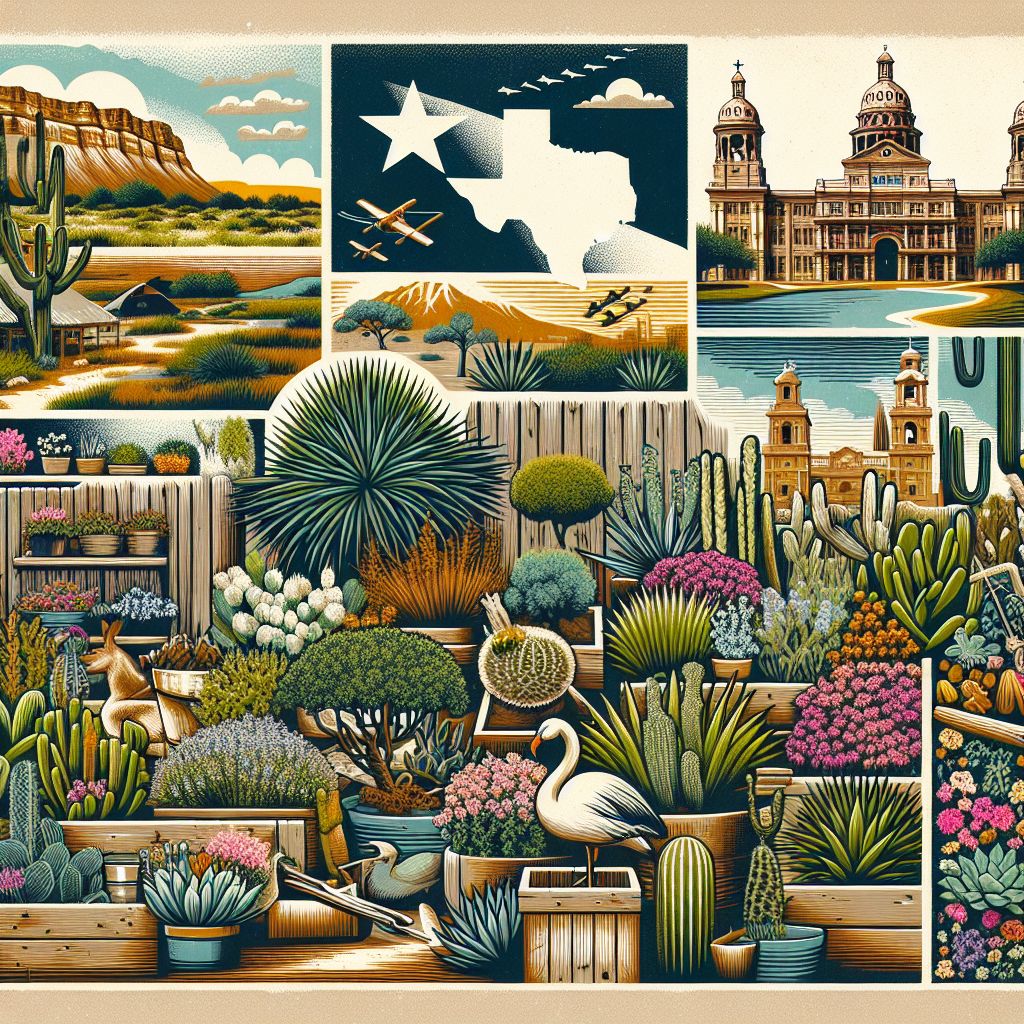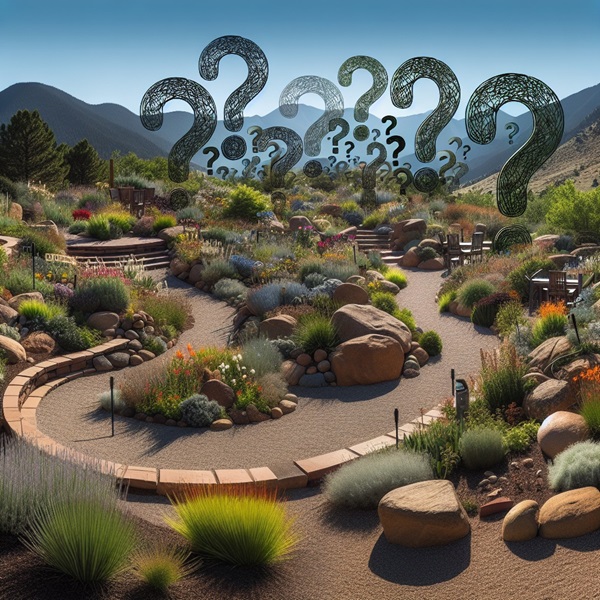
Article-at-a-Glance
- Xeriscaping is a landscaping method that conserves water by utilizing drought-resistant plants.
- In Texas,
can significantly reduce water usage due to the region’s hot and dry climate. - Native plants like Texas sage, yucca, and
are excellent choices for xeriscaped backyards. - Initial costs of xeriscaping can be offset by long-term savings on water bills and maintenance.
- Rebates and tax incentives are available for Texans who opt for xeriscaped landscapes.
Imagine stepping into your backyard and seeing a vibrant tapestry of plants that thrive in the heat, demand little water, and bring a burst of life to your outdoor space. That’s the beauty of xeriscaping, especially in Texas, where every drop of water counts. But where do you start? Let’s dig in and plant some seeds of knowledge that will grow into a lush, low-maintenance garden oasis.
Types of Plants That Grow Well in Xeriscaped Gardens
Native Texas Powerhouses: Grasses, Shrubs, and Trees
First things first, let’s talk about the backbone of any Texas xeriscape: native plants. These are the heroes that evolved to thrive in our local climate. They’re accustomed to the heat, they laugh in the face of drought, and they’ll keep your garden looking sharp with minimal fuss.
- Texas sedge: A grassy groundcover that forms a lush green carpet without the thirst of traditional lawns.
- Autumn sage: This shrub bursts with colorful flowers and invites hummingbirds to your garden party.
- Desert willow: A tree that offers delicate flowers and a weeping form, perfect for creating an elegant focal point.
These plants are just the start. With the right selection, your garden will be the talk of the neighborhood – and not just because it’s beautiful, but because it’s smart.
Succulents and Cacti: Water-Saving Wonders
Succulents and cacti are like the camels of the plant world – they store water in their leaves and stems, making them perfect for our Texas climate. Agave and yucca are two superstars that add striking form and texture to your xeriscape.
Perennial Favorites: Adaptable Beauties for Every Season
When considering drought-tolerant plants for your Texas landscape, perennials offer a variety of options that flourish throughout different seasons, providing a low-maintenance and beautiful backdrop for any xeriscaped yard.
Perennials are the gifts that keep on giving. Plant them once, and they’ll come back year after year. Plants like red yucca and Texas sage adapt beautifully to the Texas weather, offering a variety of colors and textures throughout the seasons.
Ground Covers: Soil Protectors and Visual Interest
Bare soil is a no-no in xeriscaping. It loses moisture quickly and can erode. Enter ground covers. These low-growing plants spread to cover the soil, keeping it cool and moist. Texas frog fruit and sedges are great options that add beauty while they protect.
Besides that, ground covers help suppress weeds, which means less work for you. It’s a win-win!
Blooming Beauties: Flowers That Thrive on Neglect
Consider the vibrant Texas lantana, a flower that blooms in a rainbow of colors and asks for little more than a sunny spot in your garden.
Now, let’s break down the nitty-gritty of what it takes to get your xeriscaped backyard started in terms of costs.
Costs of Creating a Xeriscaped Garden
Initial Investment: Breaking Down the Costs
Starting a xeriscape might seem like a hefty investment, but let’s put things into perspective. You’ll need to budget for:
- Plants: Native and drought-tolerant varieties may cost more upfront, but they pay off in the long run.
- Materials: Mulch, rocks, and perhaps a drip irrigation system to give your plants a drink directly at their roots.
- Design: Whether you sketch it out on a napkin or hire a pro, a good design is key to a successful xeriscape.
When you tally it up, remember: xeriscaping is an investment in your home and the environment. The upfront cost is usually between $1.50 to $2.50 per square foot, depending on your choices.
Cost Comparison: Traditional vs. Xeriscaped Gardens
Traditional lawns are thirsty, and keeping them green can be costly. Let’s compare:
| Traditional Lawn | Xeriscaped Yard |
|---|---|
| Higher water bills | Reduced water usage |
| Frequent mowing and fertilizing | Minimal maintenance |
| May need pesticides | Pesticide-free |
| Grass struggles in heat | Plants thrive in local climate |
It’s clear that over time, a xeriscaped yard will cost you less, both in terms of money and effort.
Financial Incentives: Rebates and Tax Break Opportunities
Most importantly, let’s talk about the sweet deals. Texas offers rebates and incentives for homeowners who choose to xeriscape. These can come from local water utilities or state programs and can significantly offset your initial costs.
For example, the City of Austin offers a Landscape Conversion Rebate, which gives you money back for converting thirsty turf to a drought-tolerant landscape. Check with your local authorities to see what’s available in your area.
Long-Term Savings: Water Bill Reduction and Maintenance Costs
Once your xeriscape is established, you’ll see the savings pile up. Water bills can drop by as much as 50-75%, and since you’re not mowing every weekend, you’ll save on gas and maintenance for your lawn equipment, too.
Therefore, xeriscaping isn’t just about saving water; it’s about saving time, money, and creating a sustainable slice of Texas right in your backyard. Stay tuned for the next installment where we’ll dive into the maintenance of a xeriscaped garden.
- Xeriscaping reduces the need for frequent watering, saving time and conserving water resources.
- Choosing native plants ensures a garden that is well-adapted to the local climate and requires less maintenance.
- Financial incentives from local governments can help offset the costs of transitioning to a xeriscaped yard.
- Long-term savings are realized through reduced water bills and minimal upkeep compared to traditional lawns.
- Proper maintenance, such as efficient watering practices and seasonal care, keeps a xeriscape healthy and vibrant.
Maintenance of a Xeriscaped Garden
Watering Wisdom: Tips on Irrigation Practices
While xeriscaped gardens are low-water, they’re not no-water. A smart watering schedule is key. Young plants need a bit more TLC until they’re established. After that, deep and infrequent watering encourages deep root growth, which makes plants more resilient. A drip irrigation system is your best friend here, delivering water right where it’s needed with little waste.
Trimming and Pruning: Keeping Plants Healthy
Just like any garden, a xeriscape needs some grooming. Trimming and pruning not only keep your plants looking neat but also encourage healthy growth and flowering. The trick is to prune at the right time. For most plants, that’s late winter or early spring, just before the growth season kicks in.
Mulching and Weed Control: Preventive Measures
Mulch is a xeriscape’s armor. It conserves moisture, keeps roots cool, and blocks out those pesky weeds. Organic mulches like wood chips or leaves break down over time, adding nutrients to the soil. Apply a fresh layer in the spring to keep your garden in top shape.
Seasonal Upkeep: What to Do and When
Seasons change, and so do the needs of your xeriscape. In spring, freshen up mulch and prune. Summer is for enjoying your garden and keeping an eye on watering. Fall might call for some plant division or adding new plants. Winter? Just protect from frost and plan for the coming year.
Desert-Type Gardens
Designing for Heat and Aridity: Desert Garden Basics
Desert-type gardens are a perfect match for Texas’s climate. They’re all about embracing the heat and using it to your advantage. Start with a layout that includes plenty of open space, rocks, and a mix of plant heights and types to create an interesting, layered look.
Plant Selection: Best Choices for a Desert-Themed Landscape
Choosing the right plants is crucial for a desert garden. Look for species that are not just drought-tolerant but also heat-loving. Think of agaves, ocotillos, and mesquite trees. These plants have adapted to the desert life and will thrive with little fuss.
Adding Color and Texture: Striking Features of Desert Gardens
A desert garden doesn’t have to be all greens and browns. Blooms like the Texas rainbow cactus or the
Hardscaping Elements: Rocks, Paths, and More
Hardscaping is the backbone of desert gardens. Paths made of decomposed granite, large boulders as focal points, and even dry riverbeds create structure and define spaces. They’re functional, too, guiding water flow and preventing erosion.
Table of Plants
| Plant | Description | Source |
|---|---|---|
| Abelia | A beautiful and low-maintenance plant that thrives in Texas xeriscapes. | Xeriscape Texas: A Guide to Drought-Tolerant Texas Landscaping |
| Liriope | Drought-tolerant grass-like plant perfect for adding texture to your landscape. | Xeriscape Texas: A Guide to Drought-Tolerant Texas Landscaping |
| Lantana | Low-maintenance plant favored in Texas for its ability to survive with minimal water. | Texas Landscaping with Drought-Tolerant Plants |
| Dwarf Yaupon Holly | Hardy shrub that is drought-resistant and ideal for Texas xeriscapes. | Xeriscape Texas: A Guide to Drought-Tolerant Texas Landscaping |
| Barberry | A versatile and drought-tolerant plant that adds color and interest to your outdoor space. | Xeriscape Texas: A Guide to Drought-Tolerant Texas Landscaping |
Sources:
- The Essential Guide to Drought Tolerant Plants for Texas
- Xeriscaping: Ideas for Drought-Tolerant Landscaping in Texas
- Drought Tolerant Plants & Xeriscaping | JXC | Austin Texas
- Xeriscape Texas: A Guide to Drought-Tolerant Texas Landscaping
- Texas Landscaping with Drought-Tolerant Plants
Armed with this knowledge, you’re well on your way to creating a xeriscape that’s both stunning and sustainable. Remember, it’s not just about the plants you choose; it’s about creating an ecosystem that thrives with minimal intervention. That’s the true beauty of xeriscaping in Texas.
Maintenance Schedule: Seasonal Tasks at a Glance
A xeriscaped garden still needs care, even if it’s less than a traditional garden. Here’s a quick seasonal maintenance schedule:
- Spring: Prune dead foliage, refresh mulch, check irrigation systems.
- Summer: Monitor watering, manage weeds, and enjoy your blooms.
- Fall: Plant new additions, prepare plants for winter, do a final weed check.
- Winter: Protect sensitive plants from frost, plan for spring changes.
Stick to this schedule, and your garden will reward you with year-round beauty.

Frequently Asked Questions (FAQ)
Can Xeriscaping Completely Eliminate Lawn Watering?
- Not entirely, but it can significantly reduce it. Established xeriscapes may only need supplemental watering during extended dry periods.
Xeriscaping is about smart water use, not no water use. The right plant choices and design can minimize your garden’s thirst.
Are Xeriscaped Gardens More Expensive to Implement Than Traditional Lawns?
The initial investment in a xeriscaped garden might be higher due to the cost of drought-tolerant plants and hardscaping materials. However, the long-term savings on water and maintenance often offset these costs, making xeriscaping a financially savvy choice in the long run.
How Can I Add Color to My Xeriscape Without Increasing Water Usage?
Colorful xeriscape plants, like lantana, autumn sage, and purple coneflower, provide vibrant blooms without needing extra water. Also, consider adding colorful hardscaping elements such as bright stones or decorative tiles to liven up your space.
What Are Some Common Mistakes When Starting a Xeriscaped Garden?
One common mistake is underestimating the size plants will grow to, leading to an overcrowded garden. Another is not considering the varying water needs of plants, which can lead to some plants getting too much water and others not enough.
How Does Xeriscaping Benefit Local Wildlife and Ecosystems?
Xeriscaping with native plants creates a habitat for local wildlife, such as birds and pollinators. It also helps preserve the local ecosystem by reducing water runoff and the need for chemical fertilizers and pesticides.
For homeowners in Texas looking to reduce their garden’s water consumption, xeriscaping with Texas native plants offers an excellent solution. These plants are adapted to the local climate and require minimal watering, making them ideal for creating a low-maintenance, drought-resistant yard.



